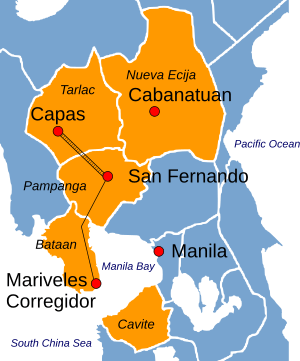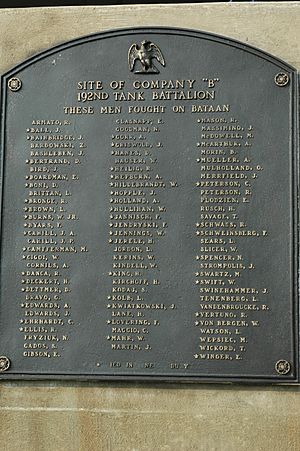Bataan Death March facts for kids
Quick facts for kids Bataan Death March |
|||||
|---|---|---|---|---|---|
| Part of the Battle of Bataan, World War II | |||||
 Route of the death march; the section from San Fernando to Capas was by rail cars. |
|||||
|
|||||
| Casualties and losses | |||||
| Many soldiers died. Estimates say between 5,650 and 18,000 prisoners died. | |||||
The Bataan Death March was a terrible event during World War II. It was a forced march of 60,000 to 80,000 American and Filipino soldiers captured by the Imperial Japanese Army. These soldiers were prisoners of war (POWs). They were forced to walk from Saysain Point, Bagac, Bataan, and Mariveles to Camp O'Donnell, Capas, Tarlac. Part of the journey, from San Fernando, Pampanga to Capas, was by train.
This forced march began on April 9, 1942. It happened after the three-month Battle of Bataan in the Philippines. The total distance marched was about 60 to 69.6 miles (96 to 112 km). Many prisoners died during the march. Estimates suggest 5,000 to 18,000 Filipino soldiers and 500 to 650 American soldiers died. The march was known for its very harsh treatment and many deaths.
After the war, the Japanese commander, General Masaharu Homma, was put on trial. He was charged with not stopping his soldiers from doing wrongful actions during the war.
Contents
The Fall of Bataan: When Soldiers Surrendered
On April 9, 1942, the Battle of Bataan ended. About 75,000 Filipino and American soldiers surrendered. They were led by Major General Edward "Ned" P. King, Jr.. The Japanese army had about 54,000 men.
The Japanese army expected about 25,000 prisoners. But almost three times that many soldiers surrendered. They were not ready to treat so many prisoners humanely.
The Death March: A Difficult Journey
On April 9, 1942, Major General Edward P. King, Jr., surrendered his troops. This was against the orders of Generals Douglas MacArthur and Jonathan Wainwright. More than 75,000 soldiers (66,000 Filipinos and 11,796 Americans) were starving and sick.
General King asked if the prisoners would be treated well. A Japanese officer replied, "We are not barbarians." However, the prisoners faced very harsh conditions. Many had their belongings stolen. They were forced to march about 90 miles (145 km) on dusty, rough roads. They were also crammed into poor train cars.
Thousands of soldiers died along the way. They suffered from disease, hunger, not enough water, heat stroke, and untreated injuries. Some were even executed. Only a few prisoners were lucky enough to ride trucks for part of the journey. But they still had to march more than 25 miles (40 km).
Prisoners were often beaten and denied the food and water they were promised. Those who fell behind were usually killed or left to die. About 54,000 of the 72,000 prisoners reached their destination. Many escaped from their guards. In total, about 5,000 to 10,000 Filipino and 600 to 650 American prisoners died before reaching Camp O'Donnell.
Prison Camps: O'Donnell and Cabanatuan
On June 6, 1942, the Japanese military released the Filipino soldiers. The American prisoners stayed in captivity. They were later moved to other camps outside the Philippines.
First, American prisoners moved from Camp O'Donnell to Cabanatuan. From Cabanatuan, many were sent to prison camps in Japan, Korea, and Manchuria. They traveled on ships known as "Hell Ships." These ships were very crowded and dangerous.
In January 1945, 511 prisoners remained at Cabanatuan Prison Camp. They were freed during a daring attack. This attack was led by United States Army Rangers. It is now known as The Great Raid.
Remembering the Bataan Death March
People remember the Bataan Death March in different ways.
In the Philippines
- Every year on April 9, the captured soldiers are honored. This day is called Araw ng Kagitingan ("Day of Valor"). It is a national holiday in the Philippines.
- In Capas, Tarlac, there is the Capas National Shrine. It is built near where Camp O'Donnell was located.
- There is also a shrine in Bataan called Dambana ng Kagitingan ("Shrine of Valor"). It remembers this event. The shrine has a large monument and a museum. A tall Memorial Cross stands 92 meters high.
In the United States
Many places in the USA also remember the Bataan Death March.
New Mexico, USA
The Bataan Death March is remembered every year at White Sands Missile Range. This is near Las Cruces, New Mexico. A march is held that covers 26.2 miles (42.2 km). About 4,000 people, including civilians and military members, take part. Some of the few remaining Bataan survivors often wait to congratulate the marchers.
Minnesota, USA
The 194th’s Company A was sent to the Philippines in 1941. To remember the prisoners, an annual Bataan Memorial March is held. It is organized by the 194th Armor Regiment of the Minnesota Army National Guard. This march takes place in Brainerd, MN. Anyone can join, and there are ten and twenty-mile distances. A ceremony is held to honor the finishers and remember the survivors and those who died.
Maywood, IL USA
For 65 years, Maywood, a town near Chicago, has held "Maywood Bataan Day." This day is on the second Sunday in September. It started in 1942 to raise awareness for nearly 100 Maywood National Guard troops. These men were captured when Bataan surrendered. They suffered through the Death March, prison camps, and slave labor in Japan. They were part of Company B of the 192nd Tank Battalion. The first Maywood Bataan Day had over 100,000 people and many famous guests. Today's event is smaller but still draws hundreds of people.
Memorials: Places to Remember
Many memorials honor the victims of the Bataan Death March.
- The Bataan Bridge in Carlsbad, New Mexico, remembers the victims.
- The Bataan-Corregidor Memorial Bridge in Chicago, Illinois, crosses the Chicago River. It honors the soldiers who defended Bataan and Corregidor.
- Highway-70 in Southern New Mexico was renamed the Bataan Memorial Highway.
- A statue of American and Filipino Bataan survivors is at Veterans Memorial Park in Las Cruces, New Mexico.
- The "A Tribute To Courage" Memorial is in Kissimmee, Florida. It shows two soldiers, one American and one Filipino, helping each other. A Filipino woman offers them water. This statue shows the friendship between the United States and the Philippines. It is the only statue in the U.S. dedicated to the heroes and survivors of Bataan and Corregidor and the Bataan Death March.
- Bataan Elementary School in Port Clinton, Ohio, remembers the 32 men from that area who were victims of the march.
Images for kids
-
Bataan Death March Memorial featuring Filipino and American soldiers at the Veterans Memorial Park in Las Cruces, New Mexico
See also
 In Spanish: Marcha de la Muerte de Bataán para niños
In Spanish: Marcha de la Muerte de Bataán para niños







